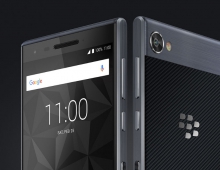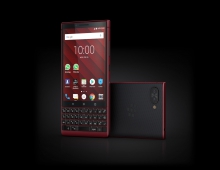Blackberry 8800
2. Design and Operation
Design:
 The first thing one notices about the 8800 is the visual similarity to the highly successful Pearl. The trackball is the same size and front and center of the device. The glossy finish is present in a sort of "midnight blue" color on the front and back and the same chrome accents that are found on the Pearl are present on the 8800.
The first thing one notices about the 8800 is the visual similarity to the highly successful Pearl. The trackball is the same size and front and center of the device. The glossy finish is present in a sort of "midnight blue" color on the front and back and the same chrome accents that are found on the Pearl are present on the 8800.
The 8800 is definitely sleek and sexy - in a very similar way to the Pearl. Those who are used to the hard, tough and rubberized finish to BlackBerry Devices might find the 8800 a little "fancy" compared to their old device. The 8800 is slippery - every surface is smooth and it feels like it could slide right out of your hand. That being said, the 8800 is designed to fit very nicely in one's hand. The size is comparable to the Motorola Q. It is wider than a Treo, but almost as narrow as a Q. It seems bigger to hold, however than the Q - that might just be an optical illusion.
The screen is wider than the Pearl, but no taller. There is a lot of space around the screen which makes me wonder why RIM didn't put an even bigger screen in this device.
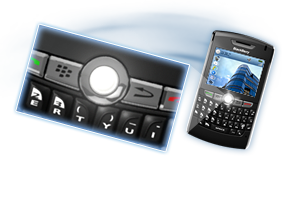 On the front of the device, under the screen, there is the trackball - front and center - with the "Escape" or "Back" key to the right and the "Menu" key to the left of the trackball. To the left of the Menu key sits the familiar "Green" phone key which places calls or accesses the phone menus and to the far right is the "Red" end or cancel key.
On the front of the device, under the screen, there is the trackball - front and center - with the "Escape" or "Back" key to the right and the "Menu" key to the left of the trackball. To the left of the Menu key sits the familiar "Green" phone key which places calls or accesses the phone menus and to the far right is the "Red" end or cancel key.
The 8800 is designed so that it can gain quick acceptance in the corporate world - that means that no camera is included. It does have Media features which are quite good - but no camera means that some in the consumer market might steer towards a more full featured smartphone.
The top of the 8800 has a dedicated on/off button on the left-hand side and the traditional BlackBerry "Mute" button on the right-hand side. There are Volume up and Volume down buttons along the right hand side of the device. Along the left hand side you can find the mini-USB charging port (the 8800 can charge off an AC adapter, the PC or the car,) a 2.5 mm earphone/headphone port (I wish it was a full 3.5 mm version so traditional headphones could be used without an adapter) and a dedicated "Convenience" button which is by default set to the Voice Command program.
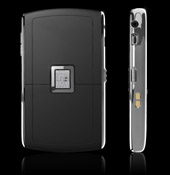 The 8800 is designed with a full QWERTY keyboard. Each key can also double for a number or symbol with a push of the ALT key. The keys are very close together - no spacing like on the Q, but they are also bigger and easier to push than the Treo keys. The keys are contoured with flat faces and rounded sides.
The 8800 is designed with a full QWERTY keyboard. Each key can also double for a number or symbol with a push of the ALT key. The keys are very close together - no spacing like on the Q, but they are also bigger and easier to push than the Treo keys. The keys are contoured with flat faces and rounded sides.
One very nice feature is the inclusion of the Micro SD card which sits in a dedicated slot under the back cover of the 8800. While this might be a little inconvenient, it is certainly better than the placement under the battery (which is how the 8100 is designed.) In reality, I find that once I insert a memory card, it stays there. If you frequently swap out your memory cards, you might find the placement inconvenient.
The 8800 as an Email Device:
BlackBerry devices are known for their email capabilities and the 8800 certainly excels in this area. The 8800 can handle up to 10 personal email accounts and also works with the BlackBerry enterprise Server for all your corporate email needs.
BlackBerry Internet Service
BlackBerry Internet Email™, part of BlackBerry Internet Service™, allows users to access up to ten personal and corporate email accounts (such as Yahoo!® and Microsoft® Exchange) from a single device
| Wireless synchronization (optional setting) | ||
|
||
| Account configuration features include: | ||
|
||
| With BlackBerry Internet Service you can also create a special BlackBerry email address just for your device. The device you are using has already been set up with a special address that looks like this: (name)@tmo.blackberry.net. | ||
BlackBerry Enterprise Server
Users can also select the BlackBerry Enterpriser Server option. Users can use this option to associate the BlackBerry Pearl with a Microsoft® Outlook, IBM® Lotus® Notes® or Novell® GroupWise® work email account and to take advantage of advanced wireless data synchronization capabilities. If a system administrator has provided an enterprise activation password, users can set up email using this option by selecting the I want to use a work email account with a BlackBerry Enterprise Server option in the setup wizard of the handset. If the user does not have an enterprise activation password, contact the system administrator.
Email setup was a snap. I used the BIS (BlackBerry Internet Service) and had my email up and running very quickly. The BlackBerry was not able to automatically configure my IMAP account, but I was able to very easily input the settings and get that working perfectly.
When email arrives, the LED in the upper right hand corner flashes red. Simply navigate to the messages icon and there is your email. A simple push on the trackball and a click of reply and you can easily type in your reply. One more click of the trackball and you send your email. It could not be easier.
The full keyboard is a nice addition. Although, I find that my emails are just as quick using the Sure-Type keyboard on the Pearl, I must say that it is nice to use a full keyboard and not have to wonder if the right word will be displayed. They keys worked well for me.
The 8800 as a Phone:
I found the call quality of the 8800 to be generally very good. I always had strong signal and never had a problem hearing callers. Callers on the other end told me that my voice sounded fine and clear. The 8800 is a full featured phone. You can make conference calls, use call forwarding, set individual ring tones and pictures for your contacts, access your call log - pretty much everything you need a phone to do.
The 8800 also includes Voice Signal's speech recognition "Voice Command" software which worked quite well. Simply say "Call X" and the Voice Command software confirms your selection, asks you whether you want "home" or "work" or "mobile" and places the call. No voice training was necessary.
When a call came in, a simple press of the Green phone key or the trackball answered the call. The 8800 also has an excellent speaker phone option which was loud and clear.
The 8800 as a PIM (Personal Information Manager)
 All your PIM needs can certainly be handled by this phone. Since this is primarily a business device (that many consumers will use) it handles calendar, address book, tasks, memos and attachments with ease.
All your PIM needs can certainly be handled by this phone. Since this is primarily a business device (that many consumers will use) it handles calendar, address book, tasks, memos and attachments with ease.
The Calendar program is very easy to use and quite powerful. It easily Syncs with either Outlook or most other popular programs and it can import your data from a .csv or tab delineated format. It was easy to navigate to the date wanted with the trackball. Click the trackball and you can easily navigate down to put in the subject of the appointment, change the date, time, duration, set alarms and set recurring appointments.
The address book can also import your information from Outlook or other programs and can also import Vcard files. I found that it even imported the pictures that I used with my contacts from Outlook. One of the nice features of the BlackBerry address book is the ability to highlight your contact, then push the menu key and scroll to send them an SMS message, email them or call them. The BlackBerry software makes these tasks very intuitive.
Tasks and memos can also easily be imported and were easy to use on the 8800. The nice amount of real estate on the screen and the bright, self adjusting light of the screen coupled with clear fonts made reading memos and tasks quite nice.
The BlackBerry 8800 is capable of viewing attachments in most formats - PDF's, Spreadsheets, Document and PowerPoints (albeit scaled down) but it cannot edit these files or open them in any other form than from attachments. For most business users, this is adequate functionality.
Multi-Media Features:
The 8800 is not designed to be a multi-media powerhouse. That being said, it does handle many multi-media tasks beautifully. Click the "Media" icon and you immediately have a choice of launching the music player, picture viewer, video player or the Ring Tones of the phone.
Music can be loaded using the desktop manager software onto the Micro SD card (to save space) into the Music subdirectory. Simply navigate to the music and play a single song, play all of your music, shuffle your songs and even show the playlist on the screen. There are no audio controls except for volume - but music sounded very good on the 8800 - certainly rivaling the sonic quality of pretty much any MP3 player.
The 8800 ships with a sample video which was remarkably smooth on the 8800. Getting my own videos to play was another matter altogether. While the 8800 does support several different video formats, most videos had to be converted to work properly on the 8800. Conversion software was available on the web, but it took hours to try to convert video properly. Getting a DVD to play involved first using "Ripping software" then "Conversion software" and was much more time consuming. This is one area where Windows Mobile has a distinct advantage.
Assigning your MP3's as ringtones was very easy, provided you have the song copied in the "Ringtone" folder on either the Micro SD card or the device itself.
The 8800 can connect to Cingular's Media net but it does not yet support streaming audio, video or the downloading of much beyond ringtones.
There are many free games, however, which can be downloaded from the BlackBerry Help bookmark in the web browser. I found Solitaire, a fishing game and several others which were easy to install, fun to play and looked great on the BlackBerry screen.
Web Browsing:
I do believe (and some disagree with me) that the BlackBerry web browser is tops in the mobile browsing field. The BlackBerry browser loads text first and quickly adds the graphics. Web pages that took close to 30 seconds to fully load on a Windows Mobile phone with a 3G connection too almost half as long to load on the BlackBerry.
Setting bookmarks was very easy as was putting in an address to go to.
One nice feature of the BlackBerry is the availability of free "Push" web services like weather, Reuters news and others. The BlackBerry will periodically go online and update the content and push it right to your phone.
I found the trackball great for web browsing - it was very easy and intuitive to move up, down, left or right on the screen using the trackball.
GPS navigation
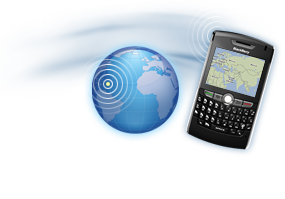 The BlackBerry 8800 is the first BlackBerry to come with a GPS receiver built in. This is a huge feature and a welcome addition. The 8800 comes with BlackBerry Maps and Telenav GPS software. Telenave is a full featured GPS program which can navigate your from your current destination to just about anywhere by either inputting your destination or finding an address from a contact on the 8800 itself.
The BlackBerry 8800 is the first BlackBerry to come with a GPS receiver built in. This is a huge feature and a welcome addition. The 8800 comes with BlackBerry Maps and Telenav GPS software. Telenave is a full featured GPS program which can navigate your from your current destination to just about anywhere by either inputting your destination or finding an address from a contact on the 8800 itself.
Because Telenav updates as you drive, there were a couple of times when the screen seemed to "lag" a bit while tracking me - but for the most part it worked fine. Telenav uses the latest maps and offers voice prompts.
One very cool feature is that while navigating with Telenav, phone calls can still be answered and the little red LED still flashes when email comes in.
Bundled Software and Accessories:
The BlackBerry 8800 come very nicely equipped - much nicer equipped than pretty any other smartphone. In the box, you get the Phone, AC charger, USB charging/Data cable, an earbud headset, stereo earphones with a Microphone, a holster, manual and CD with a great video tutorial.
Software is pretty standard issue. BlackBerry does have lots of free downloadable add ons from the BlackBerry Home page or Help page of the web browser. News readers, Push content, games and free wallpaper and ringtones can easily be found if you look for them.
One other software feature I was not able to try out is Cingular's Push to Talk feature which is included on the 8800. For those who are accustomed to this feature, I am sure they will appreciate its inclusion on the 8800.

